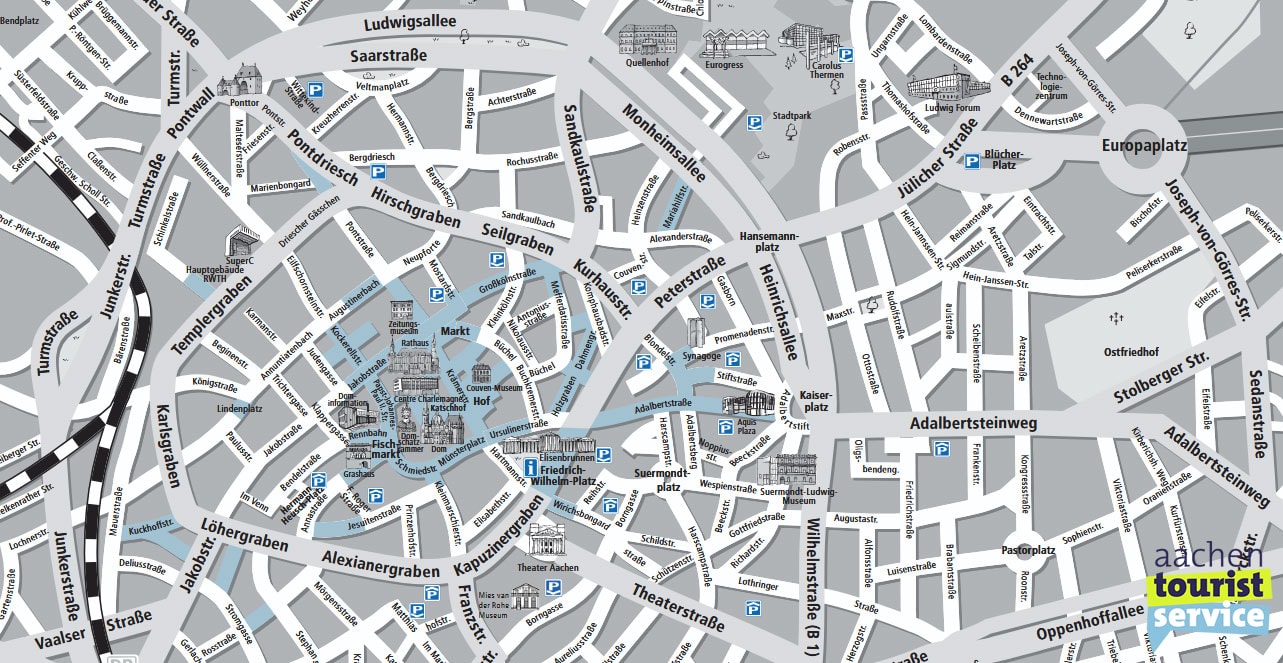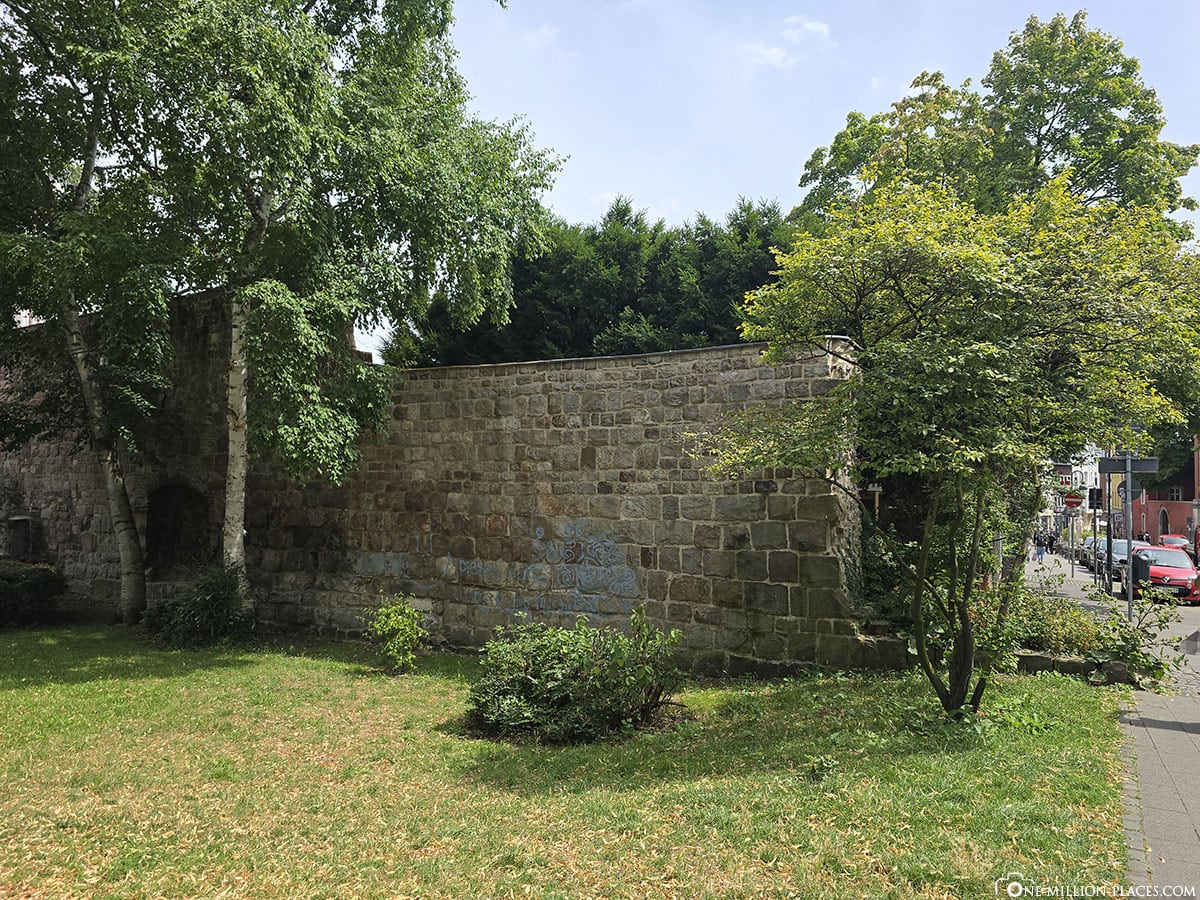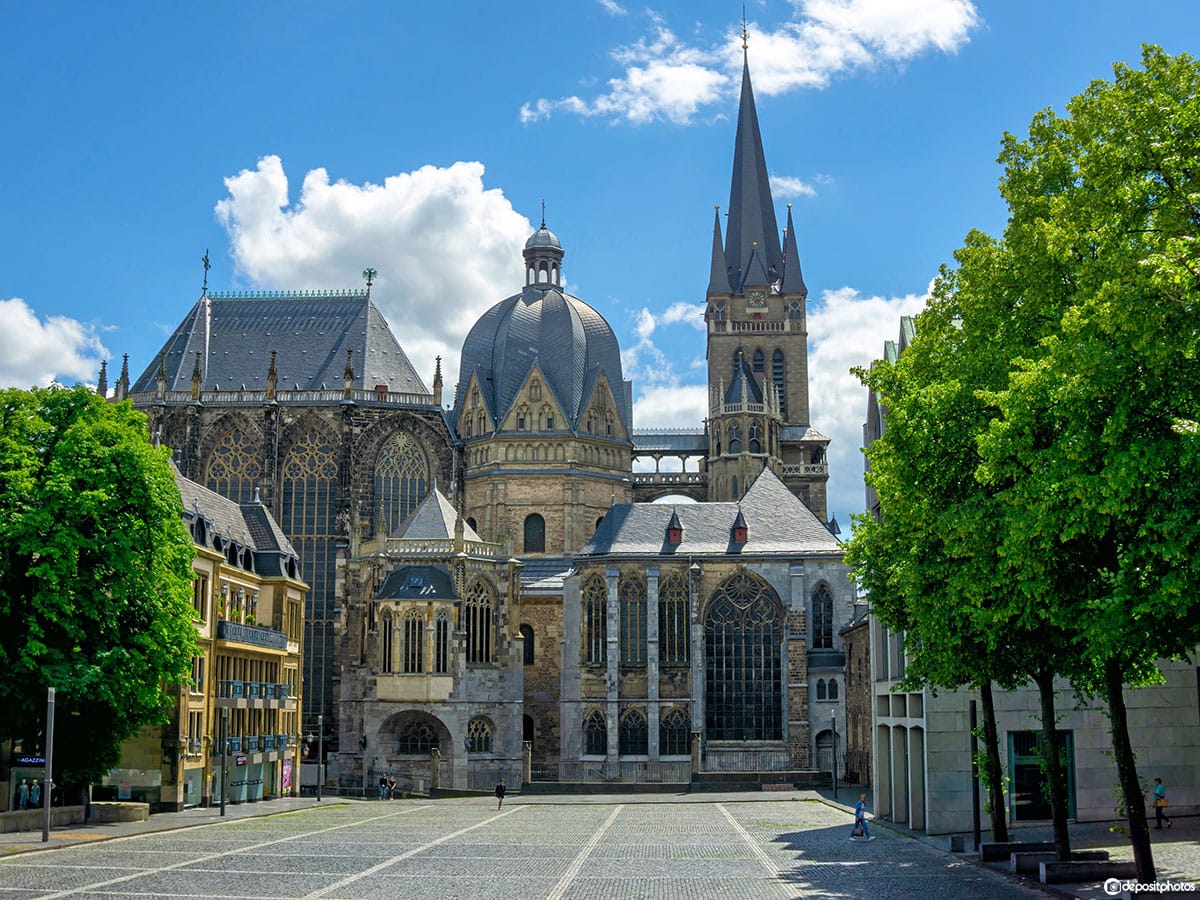We spent a few days in the northern Eifel in the summer and spent a day exploring the city of Aachen. The famous Aachen Cathedral in particular, which was the first German building to be declared a UNESCO World Heritage Site back in 1978, had long been on our bucket list.

Table of contents
Interesting facts about the city of Aachen
The city of Aachen is located in the far west of Germany in the federal state of North Rhine-Westphalia, directly on the border with Belgium and the Netherlands (border triangle). With around 250,000 inhabitants, Aachen is a lively city whose historic center is compact and easy to explore on foot. The city is also known as a university location – first and foremost thanks to the renowned Rheinisch-Westfälische Technische Hochschule (RWTH), which attracts students from all over the world.
Aachen’s historical significance goes back a long way: the Romans used the hot thermal springs and built baths here. The city was made famous above all by Charlemagne, who made Aachen his favorite palace in the late 8th century and laid the foundation stone for the later cathedral. Aachen was the coronation site of German kings for over 600 years in the Middle Ages.
City map of Aachen
On the official website of Aachen Tourism you can download a nice city map with all the important sights.
The most famous sights & photo spots in Aachen
We arrived in the city around 11 am, parked our car in the main station parking garage (location in Google Maps) and explored the old town on foot with our two kids in around 5 hours.
Former city wall
The former city wall of Aachen originally consisted of two fortification rings: an inner wall from the 12th century, often referred to as the Barbarossa Wall, and an outer wall from the 14th century. Both rings surrounded the old town and were secured with city gates, towers, kennels and a wide moat. The walls were not only used for defense, but also to control the movement of goods and to collect customs duties.
Only a few but striking remains of the once imposing complex remain today:
City gates: The Ponttor in the north and the Marschiertor in the south are completely preserved gates and impressive examples of medieval defensive architecture.
Fortified towers: Several towers such as the Long Tower, the Marienturm, the Pfaffenturm and the Adalbertsturm are still visible and have been partially restored.
Remains of the wall: Sections of the inner Barbarossa wall are preserved mainly in the area of Templergraben, Seilgraben, Minoritenstraße and Pontstraße; short sections of the outer city wall can be found on Theaterstraße and upper Mauerstraße.
Ground markings: In some places in the cityscape, the course of the walls is marked by cobblestones or information boards.
Today, these relics give a good impression of the extent and defensibility of medieval Aachen, even though large parts of the walls were demolished in the 19th century for urban redevelopment.
Pont Gate
The Ponttor is one of the two remaining city gates of the medieval fortifications and dates back to the 14th century. It was built of quarry stone and served as the northern entrance to the town. Characteristic features include the mighty walls, the frontal kennel and the pitch noses above the archway, which were used to fend off attackers. The Ponttor owes its name to the nearby “Pontstraße”, which in turn goes back to the Latin pons (“bridge”), as a bridge once crossed the city moat here.
Marching gate
The Marschiertor is the second surviving city gate of Aachen’s medieval fortifications and is located in the south of the old town. It was built around 1300 and, with its double towers around 25 meters high, is one of the mightiest gates in the Rhineland. The name “Marching Gate” is presumably derived from the fact that troops and merchants “marched” here, i.e. moved in or out of the city. Originally, the complex consisted of a main gate with a portcullis, a front castle and a drawbridge over the moat. The walls, which were up to four meters thick, provided excellent protection against attacks. Today, the gate has been restored and is used for cultural events, among other things, and is an imposing landmark reminiscent of Aachen’s fortified past.
Aachen Cathedral
Aachen Cathedral is one of the most important buildings in Europe and THE landmark of the city.
Its origins go back to the Palatine Chapel, which Charlemagne had built around 800 and which is considered an architectural masterpiece of the Carolingian period. The chapel was extended several times over the centuries, including Gothic additions such as the choir hall in the 15th century. The cathedral was the coronation church of German kings for over 600 years and served as the burial place of Charlemagne, whose marble throne can still be seen today.
With a total dome height of around 31 meters and an imposing 25-meter-high choir hall, the cathedral is impressive both in terms of its height and its proportions. The cathedral treasury, which is one of the most important ecclesiastical treasuries in the world, is particularly noteworthy. It contains precious reliquaries, liturgical objects and textile treasures from over twelve centuries, including the famous bust of Charlemagne and the Lothar Cross. The cathedral treasury is exhibited in its own museum right next to the cathedral and is just as worth seeing as the church itself.
Aachen Cathedral is open daily: usually from 7:00 am to 7:00 pm (from November to April until 6:00 pm). Admission to the cathedral is free, but there is a charge for visiting the cathedral treasury (€6 for adults).
Town hall
Aachen Town Hall was built in the 14th century on the foundations of the Carolingian Royal Hall and thus combines medieval architecture with the history of Charlemagne. It served as the seat of the city council and was also the representative location for the banquets after the royal coronations in the neighboring cathedral. The neo-Gothic style façade dates from the 19th century, while the granite tower on the north side dates from the Carolingian period. Inside, magnificent halls such as the Coronation Hall, where copies of the imperial regalia are on display, and murals depicting the deeds of Charlemagne are impressive.
Today, the town hall is not only an administrative building, but also an important landmark and a venue for cultural events. Visitors can take a guided tour of the Coronation Hall, the White Hall and other representative rooms. The outside staircase of the town hall also offers a beautiful view of the market square, which is a lively meeting place, especially during events and markets.
A great photo motif is the “Postwagen”, a historic ensemble of buildings on the east side of Aachen’s town hall, which originally consisted of two separate buildings that are now connected on the inside. The right-hand of the two half-timbered houses was known as “Zum Eulenspiegel” from around 1860 to 1910. After both houses were converted into a restaurant, the ensemble was given the name “Postwagen”. The original buildings date back to 1659, were rebuilt true to the original after severe damage during the Second World War and are now listed buildings.
Other places of interest
On our tour through the old town of Aachen, we naturally saw many more beautiful photo spots and interesting sights.
Other places worth seeing in Aachen include the Elisenbrunnen fountain with the famous Kaiserquelle spring, whose classicist 19th century Wandelhalle presents the city’s healing thermal waters and is a popular meeting place. Just a few steps away is the Archaeological Showcase, a glass pavilion in the city center in which uncovered Roman and medieval foundation remains are made visible on site. Also worth a visit is the church of St. Foillan, which is located right next to Aachen Cathedral and impresses with its late Gothic architecture, magnificent stained glass windows and a special connection to the history of the neighboring Marienmünster.
The puppet fountain in Krämerstraße is a playful work of art by Bonifatius Stirnberg from 1975: several movable bronze figures – including a knight, a jester and a professor – symbolize different facets of Aachen’s city history. The Grashaus on the fish market is one of the oldest surviving buildings in the city and served as a town hall, prison and courtroom in the Middle Ages. Today, it is home to a Route Charlemagne facility dedicated to the city’s history. The Roman portico on the south side of the cathedral is a remnant of an ancient portico and is a reminder of Aachen’s Roman origins as a spa town. Haus Löwenstein on the market square, a magnificent Gothic building from the 14th century, once belonged to wealthy citizens and is one of the few surviving medieval residential buildings in the town.
Aachener Printen – A local specialty
Aachener Printen are a traditional gingerbread cookie that is closely associated with the city of Aachen and have been produced in artisan bakeries since the 19th century. Originally, Printen were a variation on Belgian and Dutch gingerbread recipes, but Aachen developed its own spicy version. Typical is the mixture of exotic spices such as aniseed, cinnamon, cardamom, cloves, coriander and ginger, which characterize the unmistakable taste. Depending on the recipe, Printen are baked soft or hard, often refined with nuts, almonds, chocolate or icing.
Today, Aachener Printen are a protected regional product and a popular souvenir. Their aroma and variety fill the windows of bakeries, especially during the Advent season, but they are available all year round. Visitors to the city can still find original handmade Printen in many traditional businesses – and often also little stories or family recipes that have been passed down from generation to generation.
We – and especially our kids – also thought the Archimedean sandpit was really cool, which has been set up on the Katschhof at the back of the town hall every summer since 2016. 150 tons of sand are poured onto the historic Katschhof every year. Young and old can then dig, dig and chill out on deckchairs to their heart’s content 🙂
Is a visit to Aachen worthwhile?
Yes – a visit to Aachen is worthwhile, ideal for a day trip or a long weekend. The city offers interesting sights and beautiful photo opportunities with its cathedral, town hall and old city gates.




